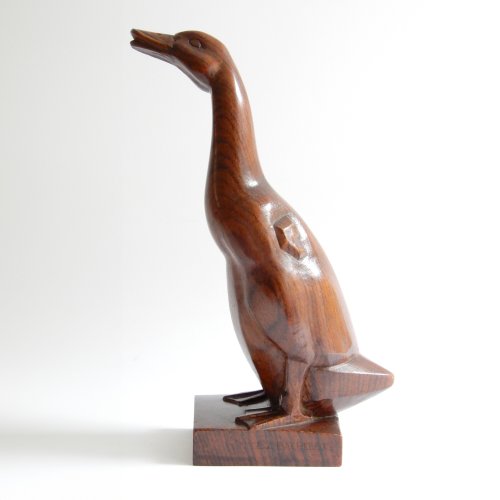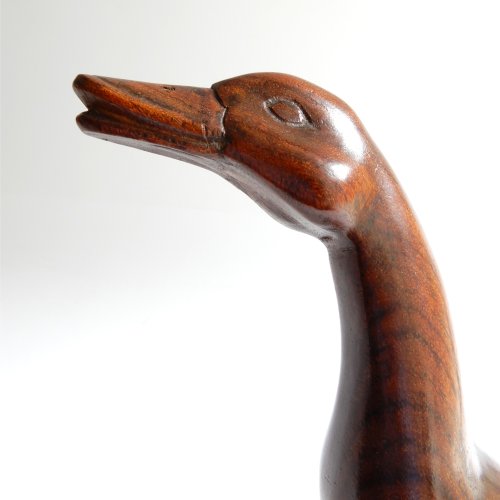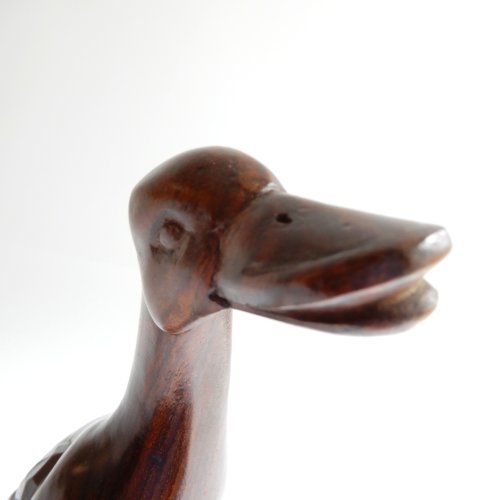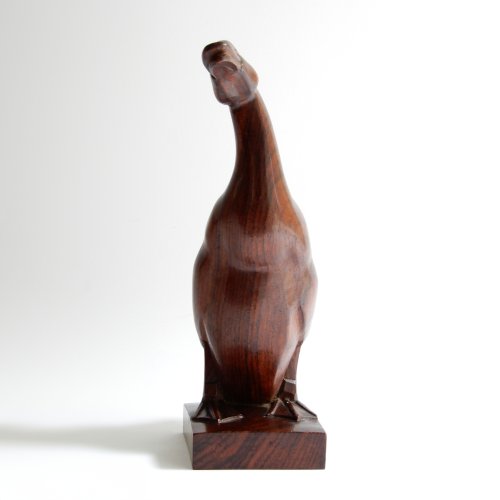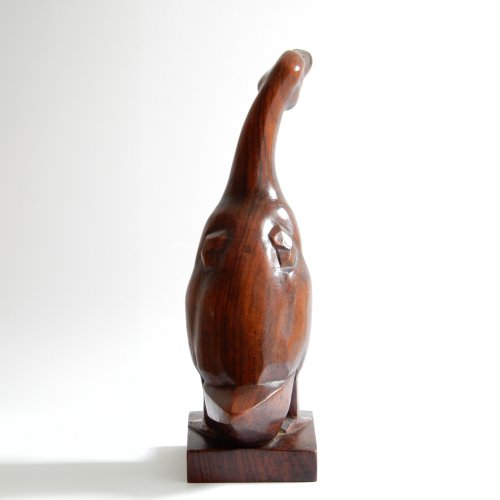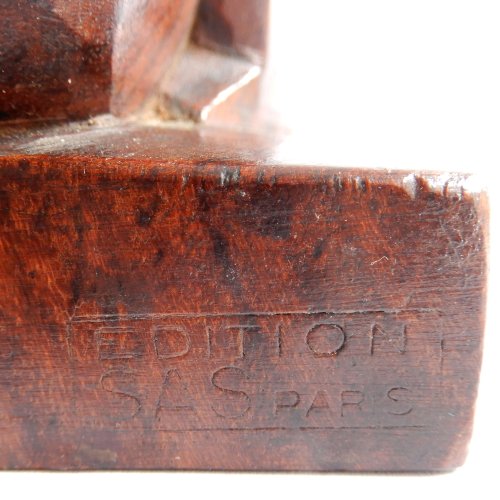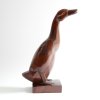Emile Just Bachelet (1892-1981) Duck - Édition S.A.S. Paris
About this piece
A beautiful large duck, presumably an Indian duck, directly carved from rosewood. It is a design by the French sculptor Emile Just Bachelet (Nancy, 1892-1981). Bachelet made several versions of the same duck in different poses, all directly carved from rosewood.
Bachelet created multiple animal figures; they are stylized yet retain their animalistic essence, almost polished. Very skilful. So touchable. Besides his wooden sculptures for SAS Paris, he also made various bronze animals. As a sculptor, he worked with diverse materials, including ivory and marble. He also created several porcelain designs for Sèvres. He was versatile and never truly specialized as an artist.
This duck was made in the late 1920s-1930s, at a time when he was already an established artist exhibiting at the Salon in Paris. He was one of the founders of S.A.S Paris. Édition S.A.S. Paris (Société des Artistes de Salon) was founded by the artists (sculptors) themselves who exhibited at the Salon des Artistes and published their work in editions. In the late 1920s and early 1930s, these wooden sculptures were exhibited at the Salon and sometimes produced in small editions for clients such as DIM (Decoration Intérieure Moderne). Artists like Adnet, Sandoz, Privat, de Canto de Maya, the Martel brothers, and of course, Emile Just Bachelet were all part of Édition S.A.S. Paris.
Today, these wooden sculptures, usually made of rosewood, are highly sought after by collectors. The quality of the carving is very high, and the editions are very small, making the works quite rare. They are often included in museum collections.
In the 1920s and 1930s, we see the emergence of commerce in the art world, at least in a form that did not exist before. Art needed to be accessible to the middle class, ideally to everyone. Thus, sculptures were cast in larger editions, often using cheaper materials than bronze, such as spelter, a mixture of metals.
Sculptors saw their work become commercial. This had positive aspects; many sculptors received opportunities they might not have had otherwise, more was possible, and innovation in art had more chances, with more connections to fashion and current trends. However, it also had negative aspects; artists were sometimes poorly paid, pressured, or under contract to produce something they did not stand behind, while the publisher always benefited financially.
By taking matters into their own hands, the artists remained their own bosses, could maintain quality, and still earn money without intermediaries. It might also have been a form of protest, but that is my personal interpretation.
The duck is well signed. On the side, there is the signature "E.J. Bachelet," on the back, within a square frame, is "S.A.S. Paris," and on the underside, the number 12 and "MADE IN FRANCE" are stamped.
The duck is beautifully patinated, entirely consistent with the age of the sculpture.
Biography
Emile Just Bachelet (Nancy, 1892-1981) was a French sculptor known for his diverse body of work, characterized by elegance, refinement, and attention to detail. Born in 1892 in Nancy, Bachelet showed an early interest in the ancient sculptures discovered in his region.
Bachelet first studied at the Académie des Beaux-Arts under Victor Prouvé, a central figure in the Art Nouveau movement, and later continued his education in Paris with Coutan.
Throughout his career, Bachelet demonstrated remarkable versatility, working with a wide range of materials, including wood, bronze, ivory, marble, and porcelain. His ivory carvings are exceptionally beautiful. His sculptures covered various subjects, from animals, especially farm animals, and human figures to decorative motifs and architectural elements. His stylization is notable—very natural yet always present. A critic in the 1920s described this as his tendency to shy away from realism.
A significant contribution of Bachelet to the art world was his involvement with Édition S.A.S. Paris (Société des Artistes de Salon), a collective founded by artists themselves to exhibit and publish their works. Bachelet's sculptures, often produced in small editions, were showcased at prestigious venues such as the Salon des Artistes, where they received widespread recognition.
Bachelet's mastery of form and technique, combined with his innate sense of aesthetics, earned him recognition as one of the leading sculptors of his time. His works were distinguished by their craftsmanship, meticulous attention to detail, and a harmonious balance between tradition and innovation.
During his long and fruitful career, Bachelet received numerous commissions for public monuments, architectural decorations, and decorative sculptures. His creations adorned private homes, public spaces, and cultural institutions.
In addition to his artistic activities, Bachelet was actively involved in the cultural life of his community, participating in exhibitions, artistic associations, and collaborative projects. His dedication to his craft and his commitment to his profession earned him the respect and admiration of his peers and patrons.
He had many commissions, was very diverse, designed facades, monuments, and created various smaller works and animal figures. He had a beautiful home and studio in Nancy, where he lived until the outbreak of WWII. He then moved to Aix-en-Provence, where he continued to work and live until his death in 1981.
Emile Just Bachelet's sculptures are still visible today in the landscape and in various museums such as the Musée des Beaux-Arts Nancy and the Musée d'Art Moderne de la Ville de Paris.
Literature:
- Thierry Roche; 'Dictionnaire biographique des sculpteurs des années 1920-30', Édition Beau-Fixe, 2007. P. 38.
- Alistair Duncan; 'Art Deco Sculpture', Thames & Hudson, London 2016. P. 371.
- Duncan, Alastair; 'Art Deco Complete - The Definitive Guide to the Decorative Arts of the 1920s & 30s', Thames & Hudson, London. 2009. P. 322, 325, and 492.
Condition
The duck is in good condition, with a minor restoration to the beak executed by a professional restorer.
Material:
Palissander
Measurements:
Length: 18 cm
(7,09")
Height: 32,5 cm
(12,8")
Period:
eind 1920-1935
Origin:
France
Artist / atelier:
Emile Just Bachelet,
